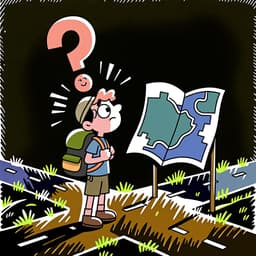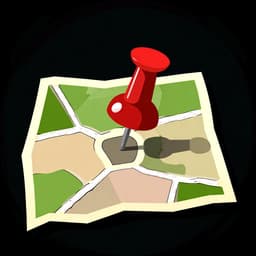Where is the train station?
in Spanish¿Dónde está la estación de tren?
/DOHN-deh ehs-TAH lah ehs-tah-SYOHN deh trehn/
This is the most direct, common, and universally understood way to ask for the train station. It's your go-to phrase and is perfectly fine in any situation, formal or informal.

Knowing how to ask '¿Dónde está la estación de tren?' is your first step to any great adventure in a Spanish-speaking country.
💬Other Ways to Say It
¿Me podría decir dónde está la estación de tren?
/meh poh-DREE-ah deh-SEER DOHN-deh ehs-TAH lah ehs-tah-SYOHN deh trehn/
This is a more polite and formal version, literally meaning 'Could you tell me where the train station is?'. It adds a layer of courtesy.
Disculpe, ¿la estación de tren?
/dees-KOOL-peh, lah ehs-tah-SYOHN deh trehn/
This is a very common, abbreviated way to ask. You're essentially saying 'Excuse me, the train station?' and letting your lost expression fill in the rest.
Busco la estación de tren.
/BOOS-koh lah ehs-tah-SYOHN deh trehn/
Instead of a direct question, this is a statement: 'I'm looking for the train station.' It functions as a request for help.
¿Sabe dónde queda la estación de tren?
/SAH-beh DOHN-deh KEH-dah lah ehs-tah-SYOHN deh trehn/
This version uses the verb 'quedar', which is often used to talk about the location of places. It means 'Do you know where the train station is located?'.
¿Cómo llego a la estación de tren?
/KOH-moh YEH-goh ah lah ehs-tah-SYOHN deh trehn/
While it means 'How do I get to the train station?', this is often used interchangeably with 'Where is...?' because it achieves the same goal: getting directions.
¿Por dónde se va a la estación de tren?
/por DOHN-deh seh vah ah lah ehs-tah-SYOHN deh trehn/
This translates to 'Which way does one go to the train station?'. It's a slightly more impersonal but common way to ask for the route.
🔑Key Words
Key Words to learn:
📊Quick Comparison
Here's a quick comparison of the most common ways to ask for the train station:
| Phrase | Formality | Best For | Avoid When |
|---|---|---|---|
| ¿Dónde está la estación de tren? | Neutral | Almost any situation; it's the universal standard. | Never wrong, but a more polite version might be better for officials. |
| ¿Me podría decir dónde está...? | Formal | Speaking to elders, police, or staff to show extra respect. | It might sound overly formal when asking a friend or someone your age. |
| Disculpe, ¿la estación de tren? | Informal | Quick, casual encounters on the street when you're in a hurry. | Addressing an official or when you need detailed, careful instructions. |
| ¿Cómo llego a la estación de tren? | Neutral | When you need step-by-step directions, not just the location. | If you just want someone to point you in the general direction. |
📈Difficulty Level
Fairly easy for English speakers. The main challenge might be the single tapped 'r' in 'tren' and keeping the vowel sounds pure.
The structure is very simple and direct. The only grammatical concept is knowing to use 'estar' for location, which is a fundamental rule for beginners.
The main nuance is remembering to be polite by using an opener like 'Disculpe'. The phrase itself is straightforward.
Key Challenges:
- Remembering to use 'estar' not 'ser' for location.
- Understanding the directions given in response.
💡Examples in Action
Perdone, señor, ¿me podría decir dónde está la estación de tren?
Excuse me, sir, could you tell me where the train station is?
¡Hola! Rápido, ¿dónde está la estación de tren? ¡Voy a perderlo!
Hi! Quick, where is the train station? I'm going to miss it!
Buenas tardes, busco la estación de tren para ir a Sevilla.
Good afternoon, I'm looking for the train station to go to Seville.
Disculpa, ¿sabes cómo llego a la estación de tren desde aquí?
Excuse me, do you know how I get to the train station from here?
🌍Cultural Context
Politeness First
In Spanish-speaking cultures, it's considered polite to start any question to a stranger with a greeting or a polite opener. Always begin with 'Disculpe' (Excuse me, formal), 'Perdón' (Pardon me), or a 'Buenos días' (Good morning) before asking your question.
Know Your Station Type
Be aware that there are different types of stations. 'Estación de tren' is for long-distance or regional trains. For subways, you'd ask for the 'estación de metro'. For buses, it's 'estación de autobuses' or 'terminal de autobuses'.
Directions are a Conversation
Don't be surprised if giving directions turns into a friendly conversation. People are often helpful and may ask where you're from or what you're doing. A smile and a 'gracias' go a long way!
Hand Gestures are Part of the Language
When you ask for directions, pay close attention to hand gestures. Pointing, indicating turns with a wave of the hand, or even using lips to point (common in some parts of Latin America) are all part of the answer. It's a visual language that complements the spoken words.
❌ Common Pitfalls
Using 'Ser' instead of 'Estar'
Mistake: "Asking '¿Dónde es la estación de tren?'"
Correction: '¿Dónde está la estación de tren?'
Mispronouncing 'Estación'
Mistake: "Pronouncing it like 'station' in English: /stay-shun/."
Correction: Breaking it into syllables: /ehs-tah-SYOHN/.
Forgetting the 'de'
Mistake: "Saying 'la estación tren'."
Correction: 'la estación de tren'.
💡Pro Tips
Have Your Destination Ready
Often, there are multiple train stations in a large city. It helps to know the name of the station or the final destination of your train, for example, 'Busco la estación de Atocha' or '¿Dónde está la estación para ir a Barcelona?'.
Learn Basic Directional Words
Your question is only half the battle! Be prepared for the answer by learning key words like 'derecha' (right), 'izquierda' (left), 'todo recto' (straight ahead), and 'cerca de aquí' (near here).
Use a Map as a Visual Aid
If you have a map (on your phone or paper), you can point to it while asking. This helps bridge any language gap and makes it easier for the person to show you the way. You can say, '¿Estamos aquí?' (Are we here?).
🗺️Regional Variations
Spain
In Spain, it's common to differentiate between long-distance trains (operated by RENFE) and local commuter trains ('cercanías'). Asking for the right one can save you time.
Mexico
While long-distance passenger train service is limited in Mexico, major cities have train systems. People are generally very friendly and willing to help with directions.
Argentina
The use of 'vos' for 'you' (informal) is universal in Argentina. 'Che' is a very common, informal interjection used to get someone's attention, similar to 'Hey' or 'Dude'.
💬What Comes Next?
After you ask where the station is.
Siga todo recto, está a dos calles.
Go straight ahead, it's two blocks away.
¡Muchas gracias!
Thank you very much!
They give you directions you don't fully understand.
Está justo al lado de la farmacia grande.
It's right next to the big pharmacy.
Perdón, no entiendo. ¿Más despacio, por favor?
Sorry, I don't understand. Slower, please?
They point you in the right direction.
Es por allí, al final de la calle.
It's that way, at the end of the street.
Vale, gracias. Muy amable.
Okay, thanks. Very kind of you.
🧠Memory Tricks
This links the Spanish sounds to a similar-sounding English question about location, reinforcing the use of 'está' for places.
The word 'estación' is a cognate (it looks and sounds similar to its English counterpart), making it easy to remember. Just connect it directly to the word 'tren'.
🔄How It Differs from English
The biggest difference is the use of 'estar' for location. In English, we use 'to be' for everything ('The station is big,' 'The station is over there'). Spanish forces you to choose between 'ser' (for identity/characteristics) and 'estar' (for location/temporary states). For places, it's always 'está'.
False Friends & Common Confusions:
Why it's different: Asking '¿Dónde es la estación?' sounds like you're asking 'Where is the station taking place?', as if it were an event. It's grammatically incorrect for location.
Use instead: Always use '¿Dónde está la estación?' for the location of a place.
🎯Your Learning Path
➡️ Learn Next:
How to ask for the metro/bus station
This applies the same sentence structure to other common forms of transportation.
How to say 'how far is it?'
A logical follow-up question after you find out where the station is.
How to say 'I need to buy a ticket'
This is the next step you'll take once you arrive at the station.
How to say left, right, and straight ahead
Essential for understanding the directions you'll receive in response.
✏️Test Your Knowledge
💡 Quick Quiz: Where is the train station?
Question 1 of 3
You need to ask an elderly woman for directions to the train station. Which phrase is the most polite and appropriate?
Frequently Asked Questions
What's the real difference between '¿Dónde está?' and '¿Dónde es?'
Think of it this way: '¿Dónde está?' asks for a location on a map ('Where is it located?'). '¿Dónde es?' asks where an event is taking place ('Where is the party?'). For physical objects and places like a train station, you must always use 'está'.
How do I ask for the bus station or metro station instead?
It's easy! Just swap out the last words. For the metro, ask: '¿Dónde está la estación de metro?'. For the bus, ask: '¿Dónde está la estación de autobuses?' The sentence structure stays the same.
What if I don't understand the directions they give me?
Don't panic! It's perfectly okay to say, 'Lo siento, no entiendo' (I'm sorry, I don't understand). You can also ask, '¿Puede hablar más despacio, por favor?' (Can you speak more slowly, please?). Most people will be happy to help.
Is it rude to just walk up and ask '¿La estación de tren?'
It's not necessarily rude, especially if you're in a hurry, but it is very direct. It's always better to start with 'Disculpe' or 'Perdón' to be more polite. A little politeness goes a long way.
Can I use 'ferrocarril' instead of 'tren'?
'Ferrocarril' technically means 'railway', but it's sometimes used to refer to the train system or station ('estación de ferrocarril'). However, 'tren' is much more common in everyday conversation. Stick with 'estación de tren' to be safe and sound natural.
📚Continue Learning Spanish Phrases
Explore More Phrases in These Categories
Find similar phrases to expand your Spanish vocabulary:
Want to Learn More Spanish Phrases?
Browse our complete collection of Spanish phrases organized by situation, from basic greetings to advanced conversations. Perfect for travelers, students, and anyone learning Spanish.
View All Spanish Phrases →




